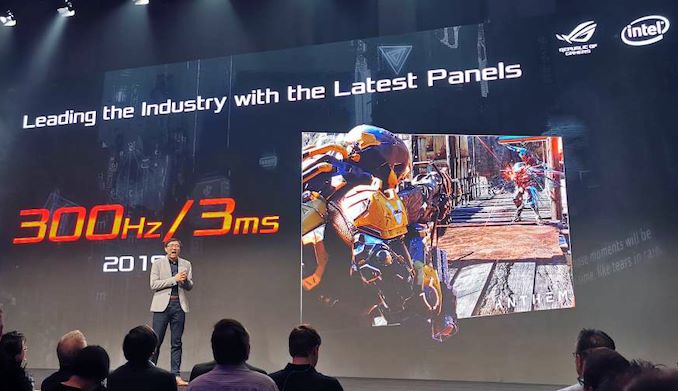It Hurtz a Lot: ASUS's New 300 Hz Laptops
by Anton Shilov on September 4, 2019 8:01 AM EST
ASUS has been at the forefront of using displays with extreme refresh rates with its ROG-series gaming laptops. The company was the first to launch notebooks with a 120 Hz LCD in 2016, was the first to release a mobile PC with a 144 Hz monitor, and then the first to produce a laptop with a 240 Hz earlier this year. At IFA, the company is demonstrating the industry’s first laptops featuring a display with a 300 Hz refresh rate.
Designed specifically for hardcore gamers and esports professionals on the go, the ASUS ROG Zephyrus S GX701 will be the world’s first notebook with a display supporting up to 300 Hz refresh rate and a 3 ms GtG response time. This machine will be available already in October, 2019. In addition, similar LCDs with a 300 Hz refresh rate and a 3 ms GtG response time will be featured on a prototype ROG Zephyrus S GX502 as well as on the 15-inch and 17-inch models of the ROG Strix Scar III.
ASUS does not disclose the maker of its 300 Hz/3 ms display panels, though it is highly likely that the company uses panels with a 240 Hz native refresh rate in overdrive mode. What is noteworthy is that production 240 Hz ROG Zephyrus S GX701 and ROG Zephyrus S GX502 will feature factory-calibrated displays with Pantone Validation, so in addition to gamers, these machines will also be appreciated by professionals who use color-critical applications.
When it comes to other hardware used by the forthcoming 300 Hz laptops and other premium mobile gaming PCs from ASUS, the company says that the flagship ROG Zephyrus S GX701 will come with NVIDIA’s GeForce RTX 2080 GPU clocked up to 1230 MHz at 100W in Turbo mode. Meanwhile, on display will be prototyes of the ROG Zephyrus S GX502 as well as the 15-inch and 17-inch flavors of the Strix Scar III with the 300 Hz display which will use NVIDIA’s GeForce RTX 2070 GPU with up to 1540 MHz GPU clock at 115W in Turbo mode. Given usage of NVIDIA's graphics processors, the laptops will also support G-Sync variable refresh rate. As these are just prototypes, it will be interesting to see if these make it to market.
As for other specifications of the new ROG Zephyrus S-series laptops will pack up to Intel's six-core Core i7-9750H processor accompanied by up to 32 GB of DDR4-2666 as well as an NVMe solid-state storage subsystem. Other specifications will be disclosed at a later date, but it is safe to assume that top-of-the-range SKUs will use premium components. Prices will depend on exact configurations.
The ASUS ROG Zephyrus S GX701, asthe industry's first laptop featuring a 300 Hz monitor, will be available this October, in time for holiday season. The manuacturer promises that similar 300 Hz panels will be available on other ROG machines in 2020.
Related Reading
- ASUS ROG 'Mothership' GZ700GX 17.3-inch G-Sync Gaming Laptop with Detachable Keyboard
- ASUS Announces The ROG Strix SCAR II GL704: Thin Bezel 17-inch
- ASUS ROG Strix Hero II & Scar II GL504 Laptops: CFL, 144 Hz, GTX 1070, New Chassis
- ASUS Launches ROG Zephyrus M (GM501): A More Traditional Flagship Gaming Notebook
- ASUS Launches the Pre-Overclocked ROG G703: 17.3-inch, 144 Hz with G-Sync, i7-7820HK, GTX 1080
- ASUS Readies ROG Laptops with Optional 120 Hz AHVA Display Panels
Source: ASUS












23 Comments
View All Comments
azrael- - Wednesday, September 4, 2019 - link
The headline pun would've been funnier with "Hertz" instead of "Hurtz".HollyDOL - Wednesday, September 4, 2019 - link
I'd be quite interested to see this...with 3ms g2g it doesn't seem to leave much time for stable colour representation, otoh if it passes Pantone...
HollyDOL - Wednesday, September 4, 2019 - link
erm, sorry, wasn't supposed to be reply on other commentIan Cutress - Wednesday, September 4, 2019 - link
I disagree 😁erinadreno - Wednesday, September 4, 2019 - link
The only games that could run at 300Hz would be either retro game or CS:GO. For others the game engine would hit a limit before the actual hardware.surt - Wednesday, September 4, 2019 - link
It's all about how soon your eye can see a change in game state. If the game engine changes state, what is the average latency to your eye seeing the result caused by a 60hz display vs a 300hz display?surt - Wednesday, September 4, 2019 - link
The answer btw: a 60hz display updates every 16.7ms, so on average you wait 8.3ms for a new frame. A 300hz display updates every 3.3ms, so on average you wait 1.2ms for a new frame. Yielding a 7.1ms advantage to the pro-gamer with the 300hz display.mdrejhon - Thursday, September 5, 2019 - link
At these small numbers, the latency benefits end.... But there are other benefits such as less motion blur and stroboscopic effects. Doubling frame rate halves motion blur.Such as this photo of a 480Hz display: https://i.imgur.com/PxvWkcK.jpg
In tests, the benefits were clearly visible to more than >75% of humans, but you needed to double refresh rate to jumpstart the diminishing curve, e.g. 240Hz -> 480Hz -> 960Hz
CRT tubes had less than 1ms motion blur. It takes 1000fps at 1000Hz to achieve 1ms motion blur if you avoid strobing/impulsing/flickering/phoshor. Doing a flickerless blurless sample-and-hold display with CRT clarity, currently requires unobtainium refresh rates.
JoeyJoJo123 - Wednesday, September 4, 2019 - link
That's not really what he's talking about, by the way. He's talking about games which specifically start encountering issues when the engine's at a high framerate. Games like GTA V are well documented to have massive stuttering issues when you hit framerates over 150fps, but can stutter even at 110+ FPS, too. Emulated games often play at unrealistic speeds if the framerate gets uncapped, etc.surt - Wednesday, September 4, 2019 - link
My point is that it doesn't matter if the game encounters an engine limit. Even if you have to framerate cap your game, you _still_ get an advantage out of your faster refresh display.